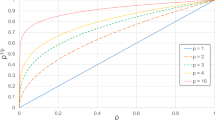Abstract
The paper presents an optimization method for direct determination of the most unfavorable imperfection of structures by means of ultimate limit states. When analyzing imperfection sensitive structures it turns out that the choice of the shape and size of initial imperfections has a major influence on the response of the structure and its ultimate state. Within the optimization algorithm the objective function is constructed by means of a fully nonlinear direct and first order sensitivity analysis. The method is not limited to small imperfections and also allows the imposition of “technological” constraints on the shape of the imperfection, thus making it possible to avoid unrealistically low ultimate loads. When carefully constructed, the objective function and constraints remain linear enabling the use of numerically efficient and readily available linear programming algorithms. Imperfection analyses are shown for thin-walled girders and a cylinder to demonstrate the applicability and efficiency of the proposed method.
Similar content being viewed by others
References
Bažant ZP, Cedolin L (2003) Stability of structures: elastic, inelastic, fracture, and damage theories. Dover Publications, Mineola
CEN (2004) Eurocode 3: Design of steel structures, Part 1.5: Plated structural elements. European Committee for Standardization, Brussels
CEN (2006) Eurocode 3: Design of steel structures, Part 1.6: Strength and stability of Shell Structures. European Committee for Standardization, Brussels
Crisfield MA (1996) Non-linear finite element analysis of solids and structures. New Ed edition. Wiley, New York, pp 362
Crisfield MA (1997) Non-linear finite element analysis of solids and structures, vol 2, Advanced Topics. Wiley, New York, p 508
Deml M, Wunderlich W (1997) Direct evaluation of the ‘worst’ imperfection shape in shell buckling. Comput Method Appl M 149: 201–222
Dinkler D, Pontow J (2006) A model to evaluate dynamic stability of imperfection sensitive shells. Comput Mech 37: 523–529
El Damatty AA, Nassef AO (2001) A finite element optimization technique to determine critical imperfections of shell structures. Struct Multidiscip O 23: 75–87
Elishakoff I (2000) Uncertain buckling: its past, present and future. Int J Solids Struct 37: 6869–6889
Ewert E, Schweizerhof K, Vielsack P (2006) Measures to judge the sensitivity of thin-walled shells concerning stability under different loading conditions. Comput Mech 37: 507–522
Godoy LA (2000) Theory of elastic stability: analysis and sensitivity. Taylor and Francis, Philadelphia
Ho D (1974) Buckling load of non-linear systems with multiple eigenvalues. Int J Non-Linear Mech 6: 649–662
Johansson B, Maquoi R, Sedlacek G, Müller C, Beg D (2005) Commentary to EN 1993-1-5 “Plated structural elements”. Luleå University of Technology
Koiter WT (1945) Over de stabiliteit van het elastisch even- wicht. Techische Hooge School, Delft. English translation : Edward Riks (1969), The stability of elastic equilibrium. Stanford University
Korelc J (2002) Multi-language and multi-environment generation of nonlinear finite element codes. Eng Comput-Germany 18: 312–327
Korelc J (2007) AceFEM, Mathematica finite element environment. University of Ljubljana, Faculty of Civil and Geodetic Engineering. http://www.fgg.uni-lj.si/Symech/
Korelc J (2007) AceGEN, Multi-Language, Multi-Environment numerical code generation. University of Ljubljana, Faculty of Civil and Geodetic Engineering. http://www.fgg.uni-lj.si/Symech/
Korelc J, Kristanič N (2005) Evaluation of design velocity field by direct differentiation of symbolically parameterized mesh. In: Onate E(eds) Plasticity: fundamentals and applications: proceedings of the eighth international conference on computational plasticity Swansea: CIMNE. Spain, Barcelona, pp 380–383
Lanzo AD, Garcea G (1996) Koiter’s analysis of thin-walled structures by a finite element approach. Int J Numer Meth Eng 39: 3007–3031
Lanzo AD (2000) A Koiter’s perturbation strategy for the imperfection sensitivity analysis of thin-walled structures with residual stresses. Thin Wall Struct 37: 77–95
Michaleris P, Tortorelli DA, Vidal CA (1994) Tangent operators and design sensitivity formulations for transient nonlinear coupled problems with applications to elastoplasticity. Int J Numer Meth Eng 37: 2471–2499
Papadopoulos V, Papadrakakis M (2005) The effect of material and thickness variability on the buckling load of shells with random initial imperfections. Comput Method Appl M 194: 1405–1426
Schenk CA, Schueller GI (2003) Buckling analysis of cylindrical shells with random geometric imperfections. Int J Non-Linear Mech 38: 1119–1132
Schmidt H (2000) Stability of steel shell structures—general report. J Constr Steel Res 55: 159–181
Schneider W (2006) Stimulating equivalent geometric imperfections for the numerical buckling strength verification of axially compressed cylindrical steel shells. Comput Mech 37: 530–536
Schneider W, Brede A (2005) Consistent equivalent geometric imperfections for the numerical buckling strength verification of cylindrical shells under uniform external pressure. Thin Wall Struct 43: 175–188
Schneider W, Tirnmel I, Hohn K (2005) The conception of quasi-collapse-affine imperfections: a new approach to unfavourable imperfections of thin-walled shell structures. Thin Wall Struct 43: 1202–1224
Song CY, Teng JG, Rotter JM (2004) Imperfection sensitivity of thin elastic cylindrical shells subject to partial axial compression. Int J Solids Struct 41: 7155–7180
Wisniewski K, Turska E (2000) Kinematics of finite rotation shells with in-plane twist parameter. Comput Method Appl M 190: 1117–1135
Wisniewski K, Turska E (2001) Warping and in-plane twist parameters in kinematics of finite rotation shells. Comput Method Appl M 190: 5739–5758
Wriggers P, Simo JC (1990) A general procedure for the direct computation of turning and bifurcation points. Int J Numer Meth Eng 30: 155–176
Wunderlich W, Albertin U (2000) Analysis and load carrying behaviour of imperfection sensitive shells. Int J Numer Meth Eng 47: 255–273
Wunderlich W, Albertin U (2002) Buckling behaviour of imperfect spherical shells. Int J Non-Linear Mech 37: 589–604
Author information
Authors and Affiliations
Corresponding author
Rights and permissions
About this article
Cite this article
Kristanič, N., Korelc, J. Optimization method for the determination of the most unfavorable imperfection of structures. Comput Mech 42, 859–872 (2008). https://doi.org/10.1007/s00466-008-0288-9
Received:
Accepted:
Published:
Issue Date:
DOI: https://doi.org/10.1007/s00466-008-0288-9




